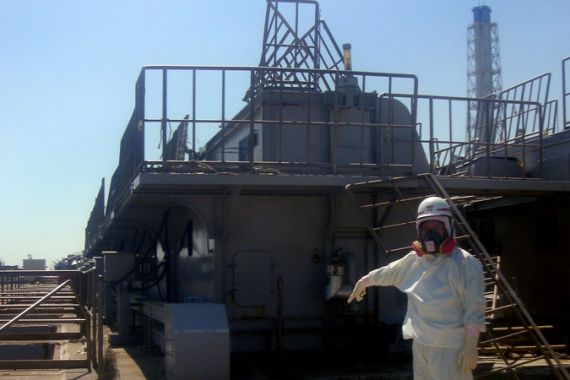Japan finally plugs radioactive leak
Nuclear operator says engineers have stop radioactive water leak but more contaminated water to be pumped into the sea.

 |
| Japan still needs to pump low-level contaminated water into the sea because of a lack of storage space [Reuters] |
Engineers have stopped highly radioactive water leaking into the sea from a crippled Japanese nuclear power plant, the facility’s operator said.
The development at the Fukushima Daiichi nuclear plant, announced on Wednesday, is a breakthrough in the battle to contain the nuclear crisis caused by last month’s earthquake and tsunami.
Keep reading
list of 4 itemsThousands evacuate as wildfire grows ‘dramatically’ in western Canada
Guardians of the glaciers – life alongside Pakistan’s vanishing ice
Photos: Kenya sanctuaries toil to save birds of prey from extinction
However, the company operating the plant, Tokyo Electric Power (TEPCO), still needs to pump low-level contaminated water into the sea because of a lack of storage space at the facility.
“The leaks were slowed yesterday after we injected a mixture of liquid glass and a hardening agent and it has now stopped,” a TEPCO spokesman told the Reuters news agency.
Engineers had been desperately struggling to stop the leaks and had used sawdust, newspapers and concrete as well as liquid glass to try to stem the flow of highly-contaminated water.
The liquid glass was injected into the ground beneath the leaking storage pit on Tuesday and stopped the leak after solidifying the earth.
Al Jazeera’s correspondent, Marga Ortigas reported from Mizusawa that “they tried many other substances before, including saw dust, newspapers and cement, but none of those worked.
“So as much as they see this as a big breakthrough, it is by no means a solution to all the valves there.
“The bottom line is that they still have reactors that are in danger of overheating, they need to continue to keep those reactors cool and to do so they need to continue to pump in water.
“And the more water is pumped in, the less storage space they have, as that water then becomes highly contaminated so still they will have a massive problem of storing 60, 000 tonnes of radioactive water.”
Engineers are already being forced to pump 11,500 tonnes of low-level radioactive water back into the sea.
‘Not yet under control’
“The situation is not under control yet,” Thomas Grieder, Asia analyst at forecasting firm IHS Global Insight, said.
“TEPCO’s decision to displace the contaminated water into the ocean reflected the urgency of clearing the turbine buildings and trenches of radioactive water so as not to damage equipment needed for restoration of cooling systems.”
|
Al Jazeera’s Marga Ortigas reports on toxic chemicals devastating Japan’s farmlands after the tsunami |
Workers are struggling to restart cooling pumps – which recycle the water – in four reactors damaged by the March 11 earthquake and tsunami that hit northeast Japan.
Until those are fixed, they must pump in water from outside to prevent overheating and meltdowns.
‘Cover plan’
Meanwhile, a plan to cover damaged reactor buildings at the Fukushima nuclear plant, with special sheets to halt radiation leakage cannot offer a quick remedy, as the sheeting will be installed in September at the earliest, government sources said.
Sources told Kyodo News that workers need to wait until radiation levels drop at the site, where hydrogen explosions have blown away the roofs and upper walls of three reactor buildings.
Some nuclear experts have been sceptical about the feasibility of the plan as they believe the step would have only limited effects in blocking the release of radioactive substances into the environment.
According to sources, a specialist from the US Nuclear Regulatory Commission said the structure of the special sheets should guarantee that spent nuclear fuel pools in the reactor buildings will not be damaged even if the sheeting is toppled by quakes or typhoons.
‘Condolence money’
TEPCO said on Tuesday it had started paying “condolence money” to local governments to aid people evacuated from around its stricken plant or affected by the radiation crisis.
The company is facing a huge compensation bill, but said it must first assess the extent of damage before paying compensation.
Radiation fears have also seen several countries ban Japanese food imports from the nuclear zone; India is the first to ban food imports from all areas of Japan over radiation fears.
Japan has called for calm over radiation concerns, but is itself considering imposing radioactivity restrictions on
seafood for the first time after contaminated fish were found.
Samples of the water used to cool reactor No. 2 were five million times the legal limit of radioactivity, officials said on Tuesday, adding to fears that contaminants had spread far beyond the disaster zone.
Small levels of radiation have been detected as far away as Europe and the west coast of the United States.